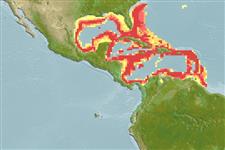Common names from other countries
Classification / Names / Names
Nomi Comuni | Sinonimi | Catalog of Fishes (gen., sp.) | ITIS | CoL | WoRMS
Environment: milieu / climate zone / depth range / distribution range
Ecologia
Associati a barriera corallina; distribuzione batimetrica 0 - 2000 m (Ref. 87091). Tropical; 33°N - 8°N, 98°W - 58°W (Ref. 847)
Western Atlantic.
Length at first maturity / Size / Peso / Age
Maturity: Lm ? range ? - ? cm
Short description
Morfologia
Colonies are encrusting to massive. Corallites with numerous septa tightly compacted giving a smooth surface. Septa are uniformly separated and reduce numbers from the wall to the columella without forming many fan-like fusions. Usually light reddish brown in color.
Zooxanthellate (Ref. 116012). Common throughout the Caribbean on protected shallow reefs or deeper reefs (Ref. 415).
Life cycle and mating behavior
Maturità | Riproduzione | Deposizione | Uova | Fecundity | Larve
Mature gametes are shed into the coelenteron and spawned through the mouth. Life cycle: The zygote develops into a planktonic planula larva. Metamorphosis begins with early morphogenesis of tentacles, septa and pharynx before larval settlement on the aboral end (Ref. 833).
Collin, R., M.C. Díaz, J. Norenburg, R.M. Rocha, J.A. Sánchez, M. Schulze, A. Schwartz and A. Valdés. 2005. (Ref. 415)
IUCN Red List Status (Ref. 130435)
CITES status (Ref. 108899)
Not Evaluated
Human uses
| FishSource |
Strumenti
Informazioni ulteriori
Age/Size
Accrescimento
Length-weight
Length-length
Morfologia
Larve
Abbondanza
Fonti Internet
Estimates based on models
Preferred temperature
(Ref.
115969): 6.2 - 16.9, mean 10.3 (based on 212 cells).
Price category
Unknown.
